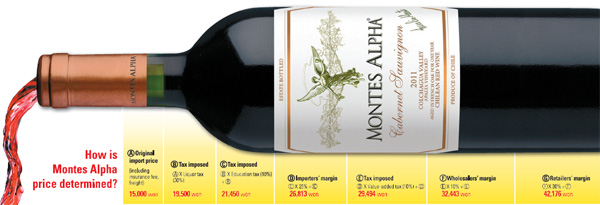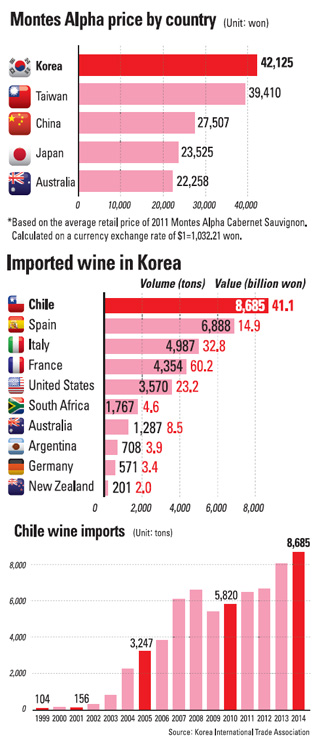Excessive cost of imported wine leaves a sour taste

Because he didn’t know much about wine, a friend recommended Montes Alpha, which he referred to as “anybody’s wine.”
But as Park saw the menu and the price of the popular Chilean wine, he wondered how an “anybody’s wine” could cost 65,000 won ($59) per bottle.
For people like Park, the price of Chilean wine is a mystery. Many local wine lovers had great expectations in 2004 when the Korea-Chile free trade agreement took effect. They thought Chilean wines would be cheaper when the 15 percent tariff was gradually eliminated in 2009.

When Consumers Korea compared the price of 2011 Montes Alpha Cabernet Sauvignon in 13 countries last year, it found that the wine sold in Korea for about 42,215 won per bottle, more than double the price in the Netherlands (18,603 won).
Currently, the retail price of the wine is 43,000 won, lower than the 47,000 won it cost in 2010, but still much more expensive than in Europe, China and Japan.
According to online wine information provider Wine-Searcher, Montes Alpha is about 18,000 won in Chile, 21,762 won in Japan and 34,000 won in China.
So why is Montes Alpha so expensive in Korea?
Industry insiders say the major culprit is the tax and distribution system. According to customs authorities and retailers, when Chilean wine lands in Korea, it is slapped with a liquor tax of 30 percent and an education tax of 10 percent. After that, the importers’ margin, which is generally 25 percent, is added, along with a value-added tax of 10 percent and markups by wholesalers (10 percent) and retailers (30 percent).
Even when including only taxes, a wine that is imported at 10,000 won per bottle could sell for 15,730 won.
In addition, the country’s liquor tax system is based on price, not quantity, meaning that expensive wines get more pricey when they come to Korea.
However, tax calculated on the import price of wine is based on a number of variables. For instance, if demand soars or there is a bad crop year, the price of wine goes up. Fluctuating currency exchange rates are another factor.
The system is different in Japan. A liquor tax of about 650 won is imposed for one bottle (750 milliliters) of wine, and there is no education tax. The value-added tax is 8 percent, lower than in Korea.
Still, the main factor in the high price is the distribution costs charged by importers, wholesalers and retailers. Although the 15 percent tariff was scrapped, the void seemed to be filled by distributors’ margins, causing consumers to complain that the price hadn’t really changed much.
But as wine competition heats up, distribution charges are going down. According to industry sources, the margin for importers is 30 to 50 percent, while wholesalers get 20 percent and retailers 30 to 40 percent.
But recent reporting by the JoongAng Ilbo showed that importers get about 30 percent, wholesalers 5 to 10 percent and retailers 5 to 30 percent, with some exceptions for hotels and luxury restaurants.
Ironically, industry insiders say it is also the fierce competition that makes wine prices stay high, as companies set the price after considering the discounts they will offer in the future.
“These days, who buys a wine at the suggested list price?” said an official from a local wine importer who asked not to be named. “Because many are offering discounts, we set the price a little higher.”
If wine were sold directly to consumers, avoiding wholesalers and retailers, prices could be cut by 20 percent, but importers say there would be other costs for rent, facility investment and labor.
In addition, unlike in the United States, Japan and Hong Kong, selling liquor directly to consumers online is prohibited. This is why consumers go to department stores and discount chain stores when the stores have wine promotions.
“The government prohibits online liquor sales because of underage drinking,” said the importer. “If it allows wine to be exempt from this law, soju and beer sellers will oppose the idea.”
Some experts say the Korean market is too small for companies to bother with cheaper wines. Industry estimates that the local wine market is valued at 500 billion won a year, compared to 173 trillion won in the United States. Korean companies claim it is hard to pursue a strategy of “quick sales and small profit.” No. 1 wine importer Keumyang International has an annual revenue of 70 billion won.
Experts also point out that wine demand is focused only on certain products and Montes Alpha is one of them.
According to data from the Korea International Trade Association, Chilean wine import volume quadrupled in the past 10 years, from 2,281 tons in 2004 to 8,685 tons in 2014. Chilean brands account for 26.5 percent of Korea’s total wine imports. And as demand soars, Chilean wineries boost prices.
“Every year, they are raising prices 3 to 5 percent a bottle,” said an official at Keumyang International. “We are trying to suppress the price hikes through negotiation, but it is too difficult.”
According to Nara Cellar, which has imported Montes Alpha wine since 1998, more than seven million bottles have been sold, the best-selling brand by far.
“Montes Alpha’s brand recognition shot up after it was selected as the party wine for the group selection event at the 2002 FIFA World Cup and APEC meeting in 2005,” said an official from Nara Cellar. “We have frozen the wine price for three years and will not change the price of 2012 Montes Alpha.”
But experts expect the price to go down as consumers look for less expensive choices.
“In Korea’s red wine market, those from Chile and France account for about 60 percent, while for white wine, Moscato and Chardonnay are dominant,” said Shin Geun-jung, E-Mart’s wine buyer. “As consumers enjoy various flavors and wine grapes, retailers will move away from expensive and premium wines to offer wines in various price ranges, which will generally push the price of all wines lower.”
BY LEE SO-AH [kjoo@joongang.co.kr]










with the Korea JoongAng Daily
To write comments, please log in to one of the accounts.
Standards Board Policy (0/250자)